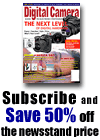|
|||||||||
|
|
Reviews
Olympus c7070 The irony of digital camera design is that the Holy Grail for professional cameras is to look and feel like film SLRs, while consumer and prosumer cameras, freed from this constraint, provide better functionality. If you watch someone who grew up using film cameras use a digital camera with an LCD display, youāll see that they keep going back to the viewfinder, even though itās not giving them nearly as accurate an idea of what their picture will be like. Anyone who started in photography with digitals, on the other hand, especially if theyāve ćgraduatedä up to the big leagues and bought a DLSR, will find that as much fun as it is to look through that SLRās lens, making the whole world look like a picture on a movie screen in a pitch black theater, having a camera glued to your face is really a drag. Iāve been waiting for digital cameras to get to the point where they can abandon the SLR form factor and come into their own. Iāve hoped that one of the classic rangefinder companies would take advantage of the similarities between their form factor and digicams, by putting something really professional out there, but though Leica and Epson both have entries in this field, neither really makes the grade. Olympus, on the other hand, has come up with a camera that very nearly fits the bill for fast-moving professional photographers at a nearly consumer camera price. Iāve been carrying one in my bag as a backup camera while Iāve had it for review, and have been delighted with its design, solid construction and especially the crisp wide-angle lens. What I like about the 7070 falls into three areas: form factor, resolution, and lens. Glenn Schwartz, product manager, isnāt overstating the case when he says that ćThe C-7070 Wide Zoom will be valued by photographers of all levels for its compact size, rugged construction and ease of use, but the powerful wide-angle lens, 7.1-megapixel image sensor and two new AF modes are features that give this camera the extra edge required by high-end amateur and professional photographers.ä
The magnesium housing is both lightweight and durable, and the lens retracts enough so that you can toss the camera into a briefcase, backpack or glove compartment to be ready for a once-in-a-lifetime shot. The 3.3 fps the camera manages in the RAW setting should help you capture the action, and when you get that shot, the 7.1 MP image will have sufficient quality for the pickiest publication. Speaking of RAW, youāve got your choice of a number of different JPG resolutions for a simultaneously saved file, something that cameras like the Nikon D70 and Canon Rebel donāt offer. You also have more choices when it comes to memory format, the camera has slots for both CF and SD cards. On the ćconä side, I wish the camera went further into pro territory, though at this price it goes further than one should expect. The max ISO equivalent is only 400, owing to the small size of the sensor needed to keep the cost down. For the price, I canāt complain, and I have to respect Olympusā conservative assignment of ISO, to control noise, but Iād be willing to pay more and to get more. The controls are a bit iconoclastic, and if youāre jumping back and forth between the 7070 and some other camera that may bother you at first. This is a camera that you can plan on keeping for a while though, so once youāve learned the ropes you should be fine. Two critical controls that are just plain badly placed take away from my raves about the body, those being the on/off switch, which is hard to get at, and the shutter release, which should be placed a bit more forward and angled down to where your thumb naturally rests.
Wide-angle lenses are subject to ćbarrel distortionä which is the tendency for lines near the edges of an image to bow outward. The 7070 suffers from this as well, but unless youāre shooting an image with straight lines at the edges, you wonāt notice it. If you would like to correct it, the software that comes with the camera includes a tool for that, or you can get an Adobe Photoshop plug-in from Panorama Tools to fix it there. In conclusion, though thereās some room left for improvement, this is a very strong camera which accomplishes its mission÷to bridge the gap between personal and professional camera and provide a serious tool for photographers that either want to work in a Digital Camera form factor or to be ready to grow into DSLRs and still have a dependable backup camera. There will undoubtedly be some who would rather have a longer telephoto than a wider lens, but thatās a matter of photographic vision. I like wider lenses because they let you capture bigger spaces, especially architectural ones like the shots of Alexandria, Virginia Iāve got here. Longer lenses keep me too far from the action, whether its people, places, or things, because I like interacting with the subject. Iād strongly recommend the camera to photography students and journalists both of which will appreciate its pro-features, compact size and affordable price. ÷Ernest
Lilley
|
||||||||
|
|
|||||||||
|
©
2004 D.C. Publications, Inc. All Rights Reserved. |
|||||||||



 The
Olympus 7070 doesnāt just blur the line between pro and consumer
cameras, it erases it. With a superb 7.1 MP CCD sensor, a 27ö 110mm
equivalent lens, and a solidly constructed magnesium body, this
camera is ready to capture the big picture and bring it back in
DCF Exif2.2, RAW, TIFF, or JPEG. Shooting speeds are up to 3.3 fps
(RAW) with ISO settings from 50-400. You can stand back and take
in the landscape, or go into super-macro mode and get as close as
an inch from your subject. The 7070 makes you stop and wonder what
defines a professional camera, and it does it for about $699 (street).
The
Olympus 7070 doesnāt just blur the line between pro and consumer
cameras, it erases it. With a superb 7.1 MP CCD sensor, a 27ö 110mm
equivalent lens, and a solidly constructed magnesium body, this
camera is ready to capture the big picture and bring it back in
DCF Exif2.2, RAW, TIFF, or JPEG. Shooting speeds are up to 3.3 fps
(RAW) with ISO settings from 50-400. You can stand back and take
in the landscape, or go into super-macro mode and get as close as
an inch from your subject. The 7070 makes you stop and wonder what
defines a professional camera, and it does it for about $699 (street).
 Theyāve
included features specifically aimed at pros, like an optional Power
Battery Holder (B-HLD20), which doubles the already substantial
battery life, a wide(r) angle converter that takes the lens down
to a 19mm equivalent and telephotos that take it up to 187 or 330mm
(equiv.) Of course, you lose a lot of light with a teleconverter.
Of course it comes with a hot shoe mount for computer controlled
flash, so thatās some help, but if youāre serious about long lenses
you should consider another camera. My favorite feature is the 1.8-inch
Semi-Transmissive swivel LCD, which, unlike every other camera I
can think of, hinges straight up from the back to make a really
convenient waist level view finder. Most cameras first have to swivel
off to the side, taking the viewfinder out of line with the lens,
and making composing your shot awkward. The 7070, on the other hand,
feels extremely natural, perfect for portraits and shooting high
or low subjects. Whether I was shooting at waist level, toe level,
or with the camera stretched as far over my head as I could reach,
aiming the camera felt natural. Light level histograms are very
useful for making sure youāre getting as much information into a
picture as you can, but the 7070 goes a step beyond to give you
a small target window within the main display so that you can see
the relative brightness of the subject as opposed to the entire
image. Itās a nice idea.
Theyāve
included features specifically aimed at pros, like an optional Power
Battery Holder (B-HLD20), which doubles the already substantial
battery life, a wide(r) angle converter that takes the lens down
to a 19mm equivalent and telephotos that take it up to 187 or 330mm
(equiv.) Of course, you lose a lot of light with a teleconverter.
Of course it comes with a hot shoe mount for computer controlled
flash, so thatās some help, but if youāre serious about long lenses
you should consider another camera. My favorite feature is the 1.8-inch
Semi-Transmissive swivel LCD, which, unlike every other camera I
can think of, hinges straight up from the back to make a really
convenient waist level view finder. Most cameras first have to swivel
off to the side, taking the viewfinder out of line with the lens,
and making composing your shot awkward. The 7070, on the other hand,
feels extremely natural, perfect for portraits and shooting high
or low subjects. Whether I was shooting at waist level, toe level,
or with the camera stretched as far over my head as I could reach,
aiming the camera felt natural. Light level histograms are very
useful for making sure youāre getting as much information into a
picture as you can, but the 7070 goes a step beyond to give you
a small target window within the main display so that you can see
the relative brightness of the subject as opposed to the entire
image. Itās a nice idea.